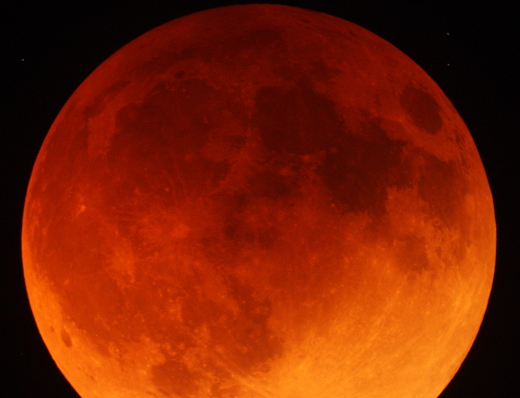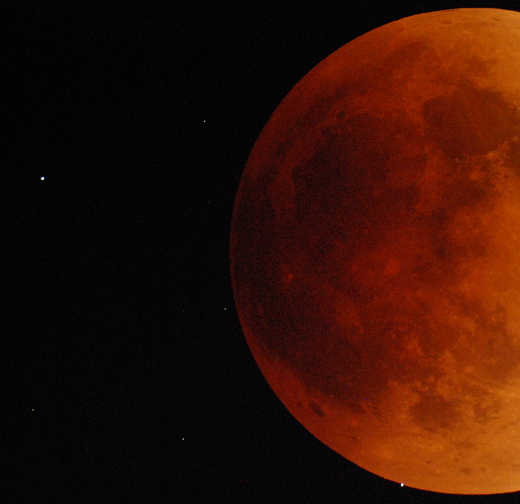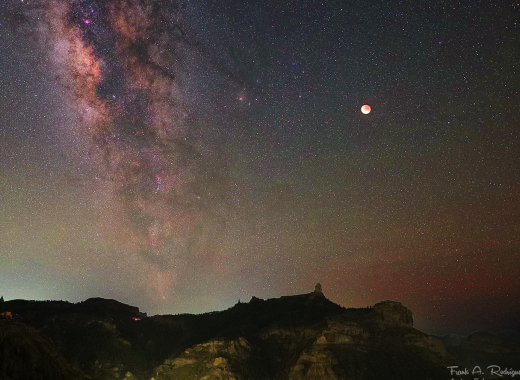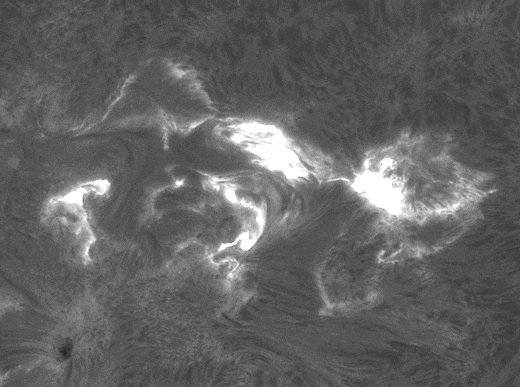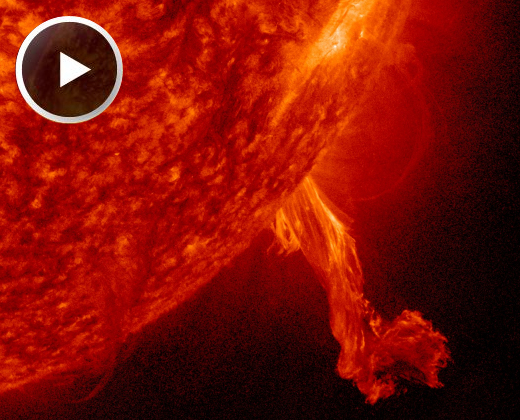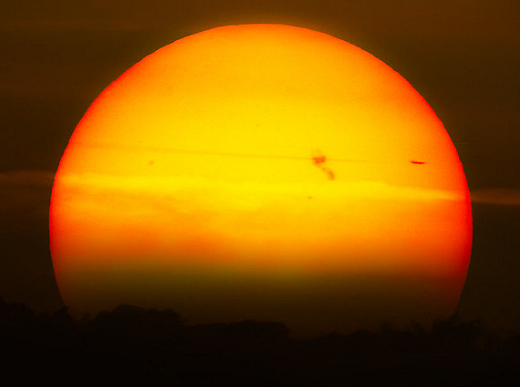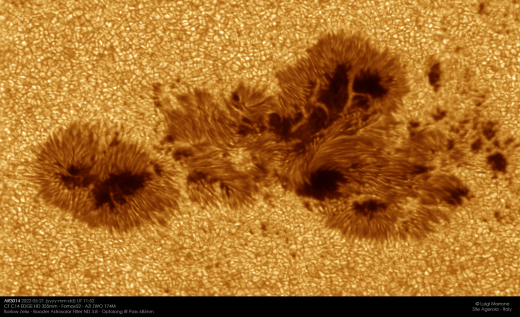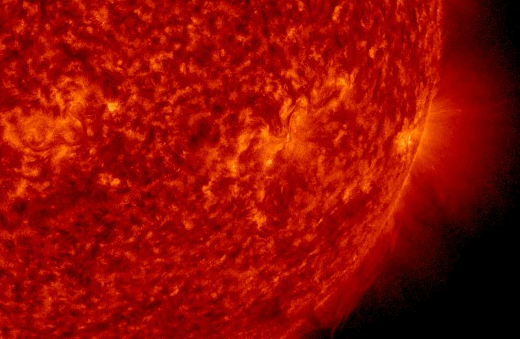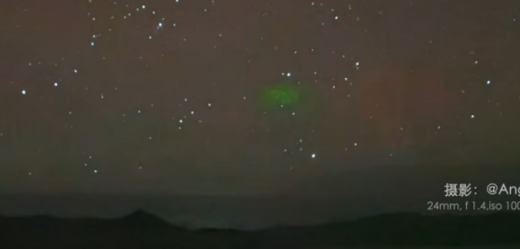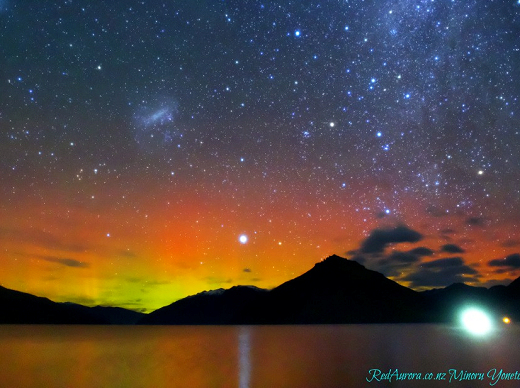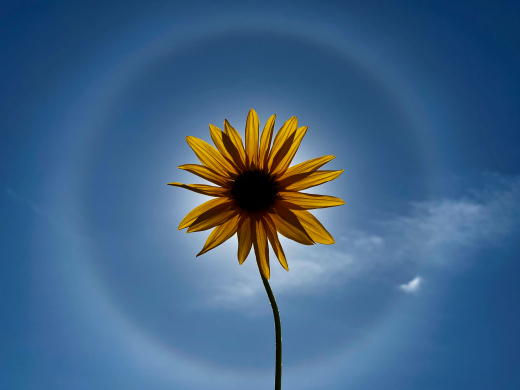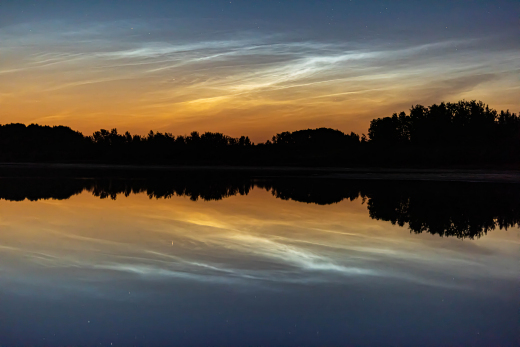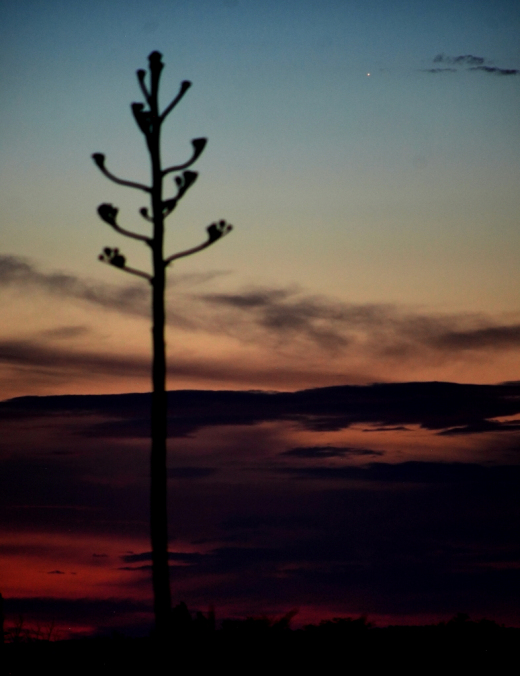3 posters
SpaceWeather updates

Carol- Admin

- Posts : 32817
Join date : 2010-04-07
Location : Hawaii
- Post n°126
 Re: SpaceWeather updates
Re: SpaceWeather updates
CHANCE OF FLARES TODAY: NOAA forecasters say there is a 35% chance of M-class solar flares today, and a 10% chance of X-flares. The most likely source would be sunspot complex AR3011-14-15, which produced an M2-class flare yesterday. Solar flare alerts: SMS Text
TOTAL ECLIPSE OF THE MOON: The full Moon just passed through the shadow of Earth, producing a total lunar eclipse. Kevin R. Witman photographed totality from Cochranville, Pennsylvania:
"I thought it was a darker eclipse compared to others I've seen with deeper shades of red and orange," says Witman. "I had to shoot a 3.2 second exposure at ISO1600 through my Meade LX50 10-inch SCT in order to collect enough light."
Many observers remarked on the darkness of totality. "It was one of the longest and darkest lunar eclipses I have ever seen!" says Thomas Leary of Portsmouth, Virginia. The lunar disk was so dark, Roberto Bartali of San Luis Potosí, Mexico, was able to see SAO159330, a dim star of magnitude +5.5 almost touching the Moon.
If the eclipse was indeed darker than usual, the Tonga volcano may be to blame. During a lunar eclipse, most of the light illuminating the Moon passes through Earth's stratosphere where it is reddened by scattering. When the Tonga volcano erupted on Jan. 15, 2022, it hurled 400 million kilograms of ash and fumes deep into the stratosphere. The volcano's lingering exhaust shaded the eclipse, making it a deeper, darker red than usual.
_________________
What is life?
It is the flash of a firefly in the night, the breath of a buffalo in the wintertime. It is the little shadow which runs across the grass and loses itself in the sunset.
With deepest respect ~ Aloha & Mahalo, Carol

Carol- Admin

- Posts : 32817
Join date : 2010-04-07
Location : Hawaii
- Post n°127
 Re: SpaceWeather updates
Re: SpaceWeather updates
FARSIDE SUNSPOTS: Today, there are 8 sunspot groups on the solar disk--the most in years. Get ready for two more. NASA's STEREO-A spacecraft is monitoring a pair of extreme ultraviolet hotspots behind the sun's eastern limb. It is probably the glow of two more sunspot groups. The active regions will rotate into view by mid-week. Solar flare alerts: SMS Text Solar windspeed: 600.1 km/sec
TOTAL ECLIPSE OF THE MOON: On Sunday night, May 15th, the full Moon passed through the shadow of Earth, producing a total lunar eclipse. "It was really dark," says Robbie Merrill, who photographed totality from Columbia, Missouri:
"The deep shade of red was amazing!" adds Merrill, whose 3-second exposure captured many faint stars around the shadowed Moon.
Many observers remarked on the darkness of totality. "This was the darkest total lunar eclipse in recent memory--about as dark as the 1993 total," says Chris Cook, of Duxbury, Massachusetts. Stars which would normally be invisible popped into view: Roberto Bartali of San Luis Potosí, Mexico, saw SAO159330 (magnitude +5.5) almost touching the Moon.
The darkness is probably a sign of volcanic ash. Earlier this year, an undersea volcano erupted near Tonga, hurling 400 million kilograms of ash and fumes deep into the stratosphere. During a lunar eclipse, most of the light illuminating the Moon passes through Earth's stratosphere where it is reddened by scattering. Lingering exhaust from Tonga almost certainly made this eclipse darker and redder than usual.
Light levels were so low, Francisco A. Rodriguez was able to photograph the Milky Way during the eclipse from the Canary Islands:
"The view was spectacular," says Rodriguez, whose exposure also captured faint bands of green airglow. Airglow is a dim upper atmospheric phenomenon usually reserved for nights when the Moon is New. It was dark, indeed.
_________________
What is life?
It is the flash of a firefly in the night, the breath of a buffalo in the wintertime. It is the little shadow which runs across the grass and loses itself in the sunset.
With deepest respect ~ Aloha & Mahalo, Carol

Carol- Admin

- Posts : 32817
Join date : 2010-04-07
Location : Hawaii
- Post n°128
 Re: SpaceWeather updates
Re: SpaceWeather updates

https://pbs.twimg.com/media/FTGmvmqXsAA-k3C?format=jpg&name=small
The sun is evolving into something old or new
https://twitter.com/metratonivvi/status/1527185089846824961?s=21&t=aqyw48vmqmu-9bTPau8f7w
INCREASING CHANCE OF FLARES: Big sunspot AR3014 has an unstable 'beta-gamma-delta' magnetic field that harbors energy for strong explosions. NOAA forecasters estimate a 35% chance of M-class solar flares and a 15% chance of X-flares on May 19th. Any eruptions will be geoeffective because the sunspot is directly facing Earth. Solar wind speed: 469.1 km/sec
ANTARCTIC LUNAR ECLIPSE: Around the world, millions of people saw this week's lunar eclipse. Only a handful saw it from Antarctica. Thomas Leps sends this picture from the geographic South Pole:
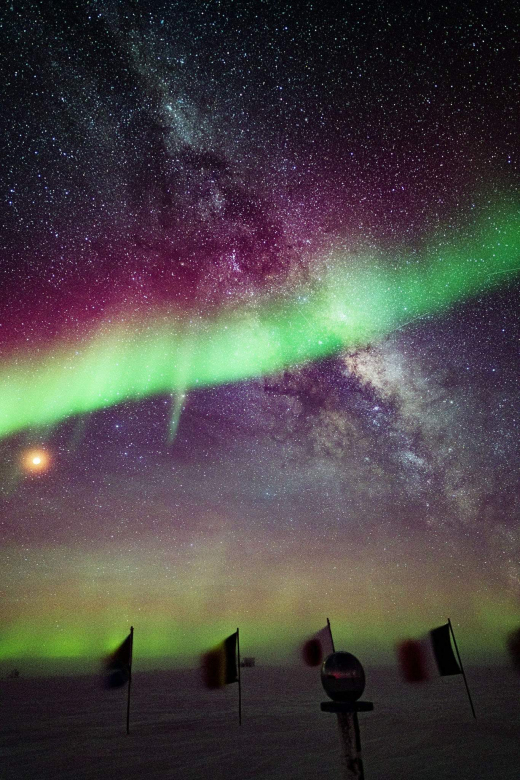
Leps operates the international BICEP array at the Amundsen–Scott South Pole Station. "We examine the polarization of the cosmic microwave background to look for evidence of gravity waves and primordial black holes in the early universe," he explains.
On May 15th he took a break to go outside and photograph the lunar eclipse.
"I was taking a time-lapse of the eclipse, but my camera shut off in the cold--the temperature was about -80F with 15 knots of wind," says Leps. "When I got it running again, a very bright aurora appeared in a single band across the entire sky, intersecting the Milky Way and passing over the eclipsed moon. I set up my camera as quickly as I could. Setting the camera can be tricky at these temperatures because the rear screen tends to freeze up after a little over a minute outside. In this case it all came together to make a great picture to remember the day by when I’m up North again."
_________________
What is life?
It is the flash of a firefly in the night, the breath of a buffalo in the wintertime. It is the little shadow which runs across the grass and loses itself in the sunset.
With deepest respect ~ Aloha & Mahalo, Carol

Carol- Admin

- Posts : 32817
Join date : 2010-04-07
Location : Hawaii
- Post n°129
 Re: SpaceWeather updates
Re: SpaceWeather updates
INCREASING CHANCE OF FLARES: Big sunspot AR3014 has an unstable 'beta-gamma-delta' magnetic field that harbors energy for strong explosions. NOAA forecasters estimate a 35% chance of M-class solar flares and a 15% chance of X-flares on May 19th. Any eruptions will be geoeffective because the sunspot is directly facing Earth. Solar flare alerts: SMS Text Solar wind speed: 487.4 km/sec
ACTIVE SUNSPOT: A storm is swirling around sunspot AR3014. This morning in Romania, astronomer Maximilian Teodorescu made a 45 minute movie of the sun's atmosphere above the huge sunspot. It is literally seething:
"I caught a pretty big M-class solar flare," says Teodorescu. In addition, dark filaments of magnetism can be seen snaking through the region as lesser flares illuminate the interstices. The tumult overlies of the biggest sunspots of Solar Cycle 25 with an unstable 'beta-gamma-delta' magnetic field that harbors energy for powerful X-flares. Stay tuned. Solar flare alerts: SMS Text
more images: from Pepe Manteca of Barcelona, Spain; from Philippe Tosi of Nîmes, France; from Sylvain Weiller of Jerusalem, Israel; from Andreas Spiering of Berg, Germany; from Alexander Golitschek of Darmstadt, Germany
JUMPING PLASMA FOUNTAINS: Today, a massive jet of plasma shot out of the sun's southwestern limb. NASA's Solar Dynamics Observatory recorded the eruption:
The base of the jet is twice as wide as Earth, and its apex is 10 times as tall. The towering plume almost certainly propelled a CME away from the sun (confirmation awaits fresh data from SOHO coronagraphs). It won't hit Earth.
What caused the eruption? First, take a look at this image and, then, replay the movie. Sunspot AR3007 launched a 'bullet' of plasma, which arced over the edge of the sun, landed, and made a really big splash. The same thing happens at Disney World.
_________________
What is life?
It is the flash of a firefly in the night, the breath of a buffalo in the wintertime. It is the little shadow which runs across the grass and loses itself in the sunset.
With deepest respect ~ Aloha & Mahalo, Carol

Carol- Admin

- Posts : 32817
Join date : 2010-04-07
Location : Hawaii
- Post n°130
 Re: SpaceWeather updates
Re: SpaceWeather updates
CHANCE OF FLARES TODAY: Big sunspot AR3014 has an unstable 'beta-gamma-delta' magnetic field that harbors energy for strong explosions. Today there is a 40% chance of M-class flares and a 5% chance of X-flares, according to NOAA. Solar flare alerts: SMS Text Solar wind speed: 520.4 km/sec
SETTING SUNSPOTS: Solar Cycle 25 is changing the way days end. The setting sun is now spotted. Valerie Liard took this picture yesterday evening from Epernay, France:
"Sunspot AR3014 was visible on the solar disk," says Liard. "A plane flew by just as I was taking the picture; the sunspot was much larger."
Indeed, AR3014 is one of the largest sunspots in years. Stretching more than 125,000 km from end to end, its length is almost 1/3rd of the distance from Earth to the Moon. AR3014 is so big it is technically a "naked eye" sunspot. In other words, you can see it without magnification. If you have a pair of eclipse glasses, put them on and take a look.
Warning: Never stare at the unfiltered sun. Liard's picture was taken when the sun was dimmed by low-hanging clouds and haze. Even then, magnified sunlight can damage your eyes. Always use safe solar filters.
A REVERSE SPLASH ON THE SUN: Sometimes movies are more fun to watch in reverse. Here's an example from May 20th. See how a dark mass of plasma falls on to the surface of the sun and makes a fiery splash:
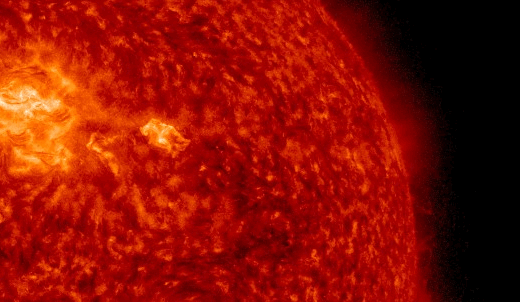
You just watched a movie of a solar flare in reverse. Here's what really happened. An emerging sunspot near AR3014 exploded, hurling a dark mass of plasma into space. The debris is not expected to hit Earth. See the original movie from NASA's Solar Dynamics Observatory.
_________________
What is life?
It is the flash of a firefly in the night, the breath of a buffalo in the wintertime. It is the little shadow which runs across the grass and loses itself in the sunset.
With deepest respect ~ Aloha & Mahalo, Carol

Carol- Admin

- Posts : 32817
Join date : 2010-04-07
Location : Hawaii
- Post n°131
 Re: SpaceWeather updates
Re: SpaceWeather updates

Why the next big solar storm might hit Earth without warning
A big solar storm could fry the internet, but at least space weather forecasts would give us a day or two to prepare. Or maybe not, because physicists have just discovered a new kind of solar storm that strikes without notice
TROUBLE brewed on 30 January 2022, although no one knew how bad it was going to be. If they had, SpaceX wouldn’t have launched 49 Starlink satellites into low Earth orbit a few days later.
It began as a giant cloud of magnetised gas, called a coronal mass ejection, hurled in our direction from the sun. That wasn’t a big concern. Sure, solar storms can heat Earth’s atmosphere, causing it to expand and drag on low-flying satellites, but all measurements suggested only mild consequences. Power grids and satellites might glitch a little and skywatchers at high latitudes might notice aurorae, but nothing serious.
Soon after the Starlink satellites launched from Florida’s Kennedy Space Center, however, it was clear something was up. When they reached Earth’s upper atmosphere, the satellites experienced much more drag than expected for the storm’s magnitude. In the end, nothing could be done. Controllers watched as 40 of the satellites were dragged down, burning up in the atmosphere in a demonstration of the sun’s capricious power.
Down here on Earth, we enjoy the benefits of energy and light from the sun. We couldn’t live without it. But we are also exposed to a constant barrage of solar wind, charged particles coming from our star. Most of the time, these only make themselves known in colourful displays of aurorae.
Every so often, however, the sun spits out a lot more material, endangering satellites and infrastructure on Earth. Usually, these come with the warning of a solar flare a day or two before they reach us. But recent research suggests some storms could appear with no warning at all. …
https://www.newscientist.com/article/mg25433870-800-why-the-next-big-solar-storm-might-hit-earth-without-warning/#ixzz7Te9LOC21
_________________
What is life?
It is the flash of a firefly in the night, the breath of a buffalo in the wintertime. It is the little shadow which runs across the grass and loses itself in the sunset.
With deepest respect ~ Aloha & Mahalo, Carol

Carol- Admin

- Posts : 32817
Join date : 2010-04-07
Location : Hawaii
- Post n°132
 Re: SpaceWeather updates
Re: SpaceWeather updates
DID A COLD INTERSTELLAR CLOUD HIT THE SOLAR SYSTEM? A new research paper by Merav Opher (Boston University) and Abraham Loeb (Harvard University) suggests that a cold interstellar cloud of gas hit the Solar System two million years ago. The impact compressed the heliosphere, making it much smaller than Earth's orbit. Our planet was completely exposed to interstellar space and a blizzard of galactic cosmic rays. If this really happened, it would have altered space weather, terrestrial climate, and possibly even human evolution. Read the preprint here.
AURORA FROTH OVER MINNESOTA: No solar flares. No CMEs. No problem. Yesterday morning in Minnesota, auroras appeared unprompted by a solar storm. Greg Ash photographed the display from Ely, MN:

"As the Moon was rising, purple pillars slowly danced across the sky," says Ash. "I could hear the owl’s hooting in the distance with beautiful star reflections in the water. It's hard to believe the planetary K-index (Kp) was only 1."
Indeed, there was no planetary geomagnetic storm. Instead, a pulse of energetic particles squirted out of Earth's magnetic tail, igniting a local display over Minnesota. This kind of event is a sign that Solar Cycle 25 is intensifying. For months, Earth's magnetic field has been buffeted by streams of solar wind and passing CMEs. Each impact adds a little energy. Over time, this process revs up the magnetosphere, turning the space around our planet into a churn of non-stop activity. This morning, Ash saw the froth. Stay tuned for more. Aurora alerts: SMS Text
MONSTER SUNSPOT: The biggest sunspot of Solar Cycle 25 is crossing the face of the sun--and it's a beauty. Or a monster. Decide for yourself. Luigi Morrone sends this picture of AR3014 from the Amalfitan Coast of Italy:
The primary dark cores of AR3014 are all wider than Earth. The entire ensemble stretches more than 125,000 km from end to end--almost a third of the distance between Earth and the Moon. These dimensions make it an easy target for safely-filtered backyard telescopes. (Morrone used a Baader Astrosolar filter attached to a Celestron 14-inch telescope.) Solar windspeed: 419.4 km/sec
_________________
What is life?
It is the flash of a firefly in the night, the breath of a buffalo in the wintertime. It is the little shadow which runs across the grass and loses itself in the sunset.
With deepest respect ~ Aloha & Mahalo, Carol

Carol- Admin

- Posts : 32817
Join date : 2010-04-07
Location : Hawaii
- Post n°133
 Re: SpaceWeather updates
Re: SpaceWeather updates
NOCTILUCENT CLOUD SEASON BEGINS: NASA's AIM spacecraft has just detected noctilucent clouds (NLCs) forming inside the Arctic Circle. NLCs are clouds of frosted meteor smoke. They should intensify in the weeks ahead, potentially spilling out of the Arctic Circle to mid-latitudes where many people can see them. Browse: NLC Photo Gallery
METEOR OUTBURST POSSIBLE NEXT WEEK: In late 1995, Comet 73P/Schwassmann-Wachmann 3 exploded. Next week, some of the debris might hit Earth.
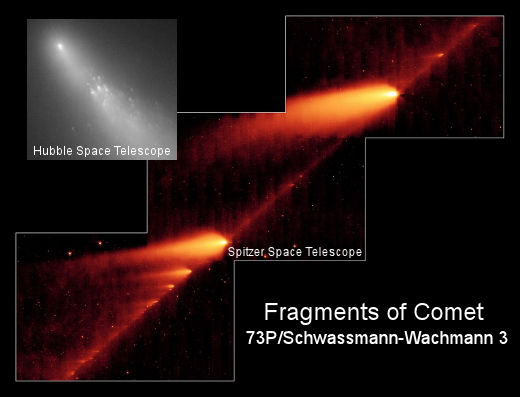
Above: NASA images of Comet 73P still crumbling years after its initial breakup. [more]
Whatever happens, people in North America are in a good position to see it. Almost the entire continent will be in Moon-free darkness when the shower peaks. Maximum activity is expected around 1:00 am Eastern Daylight Time (05:00 UT) on Tuesday morning, May 31st. The shower's radiant (the point from which all meteors stream) will be almost straight above Baja California.
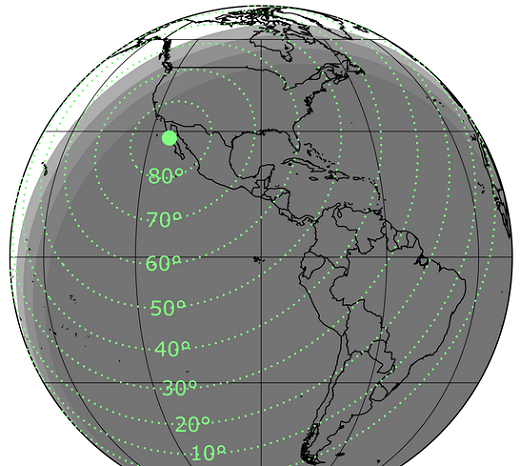
Above: Altitude contours for the shower's radiant. Baja California is favored with zenith observing geometry. Image credit: Josselin Desmars (IMCCE/IPSA) [more]
Based on past performance, the tau Herculids seem unlikely to produce a good show. For nearly a century the shower has been a dud. The X-factor this year is fresh material from the comet's catastrophic breakup. If the new meteoroids reach Earth--and that is a big IF--shooting stars will fly from a point near the bright star Arcturus in the constellation Bootes. Here is a sky map to help you find it.
To learn more about the tau Herculid meteor shower, we recommend [url=https://imo.net/papers/Comet 73PSchwassman-Wachman-Joe-Rao.pdf]this comprehensive paper[/url] by Joe Rao, a lecturer at the Hayden Planetarium in New York. Also, a new analysis by Jérémie Vaubaillon of the Institute for Celestial Mechanics and Computation of Ephemerides in Paris raises the possibility of two additional outbursts on May 31st resulting from debris shed by Comet 73P in the years 1892 and 1897.
_________________
What is life?
It is the flash of a firefly in the night, the breath of a buffalo in the wintertime. It is the little shadow which runs across the grass and loses itself in the sunset.
With deepest respect ~ Aloha & Mahalo, Carol

Carol- Admin

- Posts : 32817
Join date : 2010-04-07
Location : Hawaii
- Post n°134
 Re: SpaceWeather updates
Re: SpaceWeather updates
METEOR OUTBURST POSSIBLE NEXT WEEK: Debris from shattered Comet 73P/Schwassmann-Wachmann 3 is approaching Earth. ETA: May 31st. Forecasters aren't certain, but there could be a meteor outburst when the material arrives. North Americans are favored to see the show if it actually happens. Estimates of visual meteor rates range from near zero to thousands per hour, highlighting the uncertainty of the forecast. [full story] [sky map]
A DEAD SUNSPOT EXPLODES (UPDATED): A magnetic filament snaking through the corpse of decayed sunspot AR3016 erupted on May 25th (1824 UT), producing a M1-class solar flare. NASA's Solar Dynamics Observatory recorded the blast:
[size]
Coronagraph images from the Solar and Heliospheric Observatory (SOHO) confirm that the explosion hurled a CME into space. A first look at the data suggests that the bulk of the CME will miss Earth, but there appears to be an Earth-directed component as well. A fraction of the CME could hit our planet on May 28th or 29th. Computer modeling by NOAA analysts will soon refine the arrival time. Stay tuned. Solar flare alerts: SMS Text
[/size]
A DEAD SUNSPOT EXPLODES (UPDATED): A magnetic filament snaking through the corpse of decayed sunspot AR3016 erupted on May 25th (1824 UT), producing a M1-class solar flare. NASA's Solar Dynamics Observatory recorded the blast:
[size]
Coronagraph images from the Solar and Heliospheric Observatory (SOHO) confirm that the explosion hurled a CME into space. A first look at the data suggests that the bulk of the CME will miss Earth, but there appears to be an Earth-directed component as well. A fraction of the CME could hit our planet on May 28th or 29th. Computer modeling by NOAA analysts will soon refine the arrival time. Stay tuned. Solar flare alerts: SMS Text
[/size]
On May 25, 2022, the network reported 3 fireballs.
(3 sporadics)
(3 sporadics)
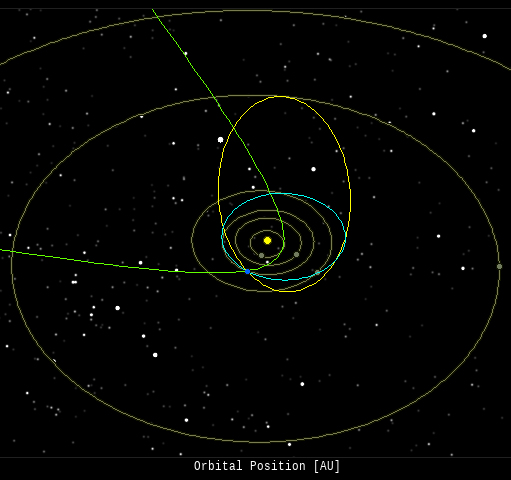
In this diagram of the inner solar system, all of the fireball orbits intersect at a single point--Earth. The orbits are color-coded by velocity, from slow (red) to fast (blue). [Larger image] [movies]
_________________
What is life?
It is the flash of a firefly in the night, the breath of a buffalo in the wintertime. It is the little shadow which runs across the grass and loses itself in the sunset.
With deepest respect ~ Aloha & Mahalo, Carol

Carol- Admin

- Posts : 32817
Join date : 2010-04-07
Location : Hawaii
- Post n°135
 Re: SpaceWeather updates
Re: SpaceWeather updates
GEOMAGNETIC STORM WATCH: Minor G1-class geomagnetic storms are possible on May 28th when a CME is expected to sideswipe Earth's magnetic field. The solar storm cloud was hurled into space by an unstable magnetic filament, which erupted on May 25th. High-latitude auroras are possible this weekend. Geomagnetic storm alerts: SMS Text
A 'GREEN GHOST' OVER TIBET: Three years ago, a photographer in Oklahoma discovered the first "Green Ghost"--a patch of verdant light that appears when powerful sprites strike the top of Earth's atmosphere. Now the phenomenon has been detected in Tibet as well. Soheil Esy was trekking through the Himalaya on May 19th when this spectcular wall of sprites lit up the night sky:
"This happened on my 13th night of star chasing in Tibet, carrying 4 camera stands and lenses with multiple focal lengths," says Esy. "I have always believed that you should give yourself completely to nature, wait and prepare unceasingly, and the sky will reward you with more than you can imagine. My patience was definitely rewarded."
"The outbreak was triggered by strong lightning over China, perhaps hundreds of kilometers away," he continues. "We could also see ripples of red airglow surrounding the sprites. It was truly the fireworks of the Universe."
After one outburst subsided, Esy photographed a green afterglow--the Green Ghost:
Researchers are still learning about this phenomenon. A leading theory holds that Green Ghosts appear when the tops of strong sprites hit the airglow layer ~90 km above Earth's surface. Oxygen atoms briefly glow green, marking the location of the impact.
"I believe this could be the first Green Ghost sighted over China," says Esy, "and the image could provide valuable data for research."
_________________
What is life?
It is the flash of a firefly in the night, the breath of a buffalo in the wintertime. It is the little shadow which runs across the grass and loses itself in the sunset.
With deepest respect ~ Aloha & Mahalo, Carol

Carol- Admin

- Posts : 32817
Join date : 2010-04-07
Location : Hawaii
- Post n°136
 Re: SpaceWeather updates
Re: SpaceWeather updates
GEOMAGNETIC STORM WATCH: Minor G1-class geomagnetic storms are underway this weekend as Earth moves through a stream of high-speed (> 500 km/s) solar wind. The gaseous material is flowing from a hole in the sun's atmosphere. Storminess could increase later today, May 28th, when a CME is expected to sideswipe Earth's magnetic field. Solar wind speed: 511.6 km/sec density
_________________
What is life?
It is the flash of a firefly in the night, the breath of a buffalo in the wintertime. It is the little shadow which runs across the grass and loses itself in the sunset.
With deepest respect ~ Aloha & Mahalo, Carol

Carol- Admin

- Posts : 32817
Join date : 2010-04-07
Location : Hawaii
- Post n°137
 Re: SpaceWeather updates
Re: SpaceWeather updates
A METEOR OUTBURST MIGHT HAPPEN TONIGHT: Yes, debris from Comet 73P/Schwassmann-Wachmann 3 might actually be approaching Earth. Last Friday, a camera operated by the Spanish Meteor and Fireball Network caught a piece of the broken comet disintegrating over Europe. The fireball they saw could herald a larger cloud of debris following close behind. If it exists, the approaching cloud could cause a meteor outburst over North America on the night of May 30-31. That's tonight! Probably nothing will happen, but for enthusiasts it's worth a look. [full story] [sky map] [observing tips] Solar wind speed: 546.9 km/sec
SOUTHERN LIGHTS: A co-rotating interaction region (CIR) hit Earth's magnetic field on May 27th. The impact sparked 12 hours of geomagnetic storming (G1-class) and a rare display of Southern Lights. Minoru Yoneto sends this deep-sky exposure from Queenstown, New Zealand:
"Here in the South Island of New Zealand, where the leaves have fallen and the ski slopes will open next month, the temperature outside was already below 3 degrees Celsius when I left home," says Yoneta. "I took all the precautions I could to keep warm!"
CIRs are transition zones between fast- and slow-moving streams of solar wind; they contain shock waves and enhanced magnetic fields that can spark bright auroras. This one certainly did. The display was also seen in the northern hemisphere as far south as Michigan and Wisconsin. Aurora alerts: SMS Text
more images: from Marybeth Kiczenski of Mackinaw City, Michigan; from Brian Larmay of Pembine Wisconsin; from Rodrigo Roesch of Kewaunee, Wisconsin; from Tim Wieland of Charlevoix, Michigan; from Shayne Smith of Manistique, Michigan;
BLACK-EYED SUSAN CORONAGRAPH: A coronagraph is a device that blocks the sun, producing a total eclipse. On May 26th, Richard Sears of Ballico, California, used a Black-eyed Susan for this purpose:
"I guess you could say I gave the sun a black eye," says Sears.
The ring of light around the flower is a 22-degree sun halo. It was caused by ice crystals in high cirrus clouds. "The halo persisted for more than 8 hours," marvels Sears. "That's a record for around here."
Coronagraphs are real scientific instruments. The Solar and Heliospheric Observatory (SOHO) uses one to track CMEs and sundiving comets--objects which are easily overwhelmed by intense sunlight. SOHO coronagraphs are made of lenses, filters, opaque disks, and polarizer wheels. Note to researchers: Rudbeckia hirta works, too.
_________________
What is life?
It is the flash of a firefly in the night, the breath of a buffalo in the wintertime. It is the little shadow which runs across the grass and loses itself in the sunset.
With deepest respect ~ Aloha & Mahalo, Carol

Carol- Admin

- Posts : 32817
Join date : 2010-04-07
Location : Hawaii
- Post n°138
 Re: SpaceWeather updates
Re: SpaceWeather updates
CME NEAR-MISS POSSIBLE ON JUNE 5TH: A minor coronal mass ejection (CME) that left the sun on June 1st will pass close to Earth on June 5th, according to NOAA analysts. It might come close enough for a glancing blow. High latitude sky watchers should be alert for auroras when the CME arrives this weekend. Aurora alerts: SMS Text.
NOCTILUCENT CLOUDS: They're back. Noctilucent clouds (NLCs) have returned to the northern hemisphere. On June 1st, Harlan Thomas photographed the silvery ripples over Gayford Pond northeast of Calgary, Alberta:
"Yay!" says Thomas. "The first night of NLCs in Alberta for 2022 was very nice start to our season."
NLCs are Earth’s highest clouds. They form when summertime wisps of water vapor rise to the edge of space (~83 km high) and crystallize around disintegrated meteoroids. When you see one, you’re literally seeing a cloud of frosted meteor smoke.
NASA's AIM spacecraft detected the season's first NLCs near the North Pole on May 22nd. Now they are spreading. Gayford Pond is at latitude +51N. Soon, the clouds will be even further south, probably reaching mid-latitudes by the second week of June. To see them, look west 30 to 60 minutes after sunset (or before sunrise) when the sun is just below the horizon.
_________________
What is life?
It is the flash of a firefly in the night, the breath of a buffalo in the wintertime. It is the little shadow which runs across the grass and loses itself in the sunset.
With deepest respect ~ Aloha & Mahalo, Carol

Carol- Admin

- Posts : 32817
Join date : 2010-04-07
Location : Hawaii
- Post n°139
 Re: SpaceWeather updates
Re: SpaceWeather updates
CME NEAR-MISS POSSIBLE ON JUNE 5TH: A minor coronal mass ejection (CME) that left the sun on June 1st will pass close to Earth on June 5th, according to NOAA analysts. It might come close enough for a glancing blow. High latitude sky watchers should be alert for auroras when the CME arrives this weekend. Aurora alerts: SMS Text.
SOLAR CYCLE 25 UPDATE: Once again, Solar Cycle 25 is exceeding predictions. Sunspot numbers in May 2022 more than doubled NOAA's forecast, setting the stage for a relatively strong Solar Maximum in early 2025.
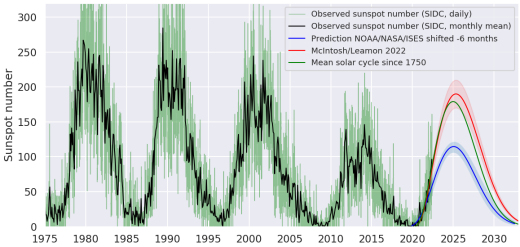
Image credit: Helio4cast, a group of scientists based in Austria working on basic and applied space weather research.
The plot, above, compares actual sunspot numbers to a selection of benchmarks. The blue curve is the "official forecast" issued by NOAA's Solar Cycle Prediction Panel in 2019. Sunspot counts are tracing a curve significantly higher than that.
The green curve is the average of all solar cycles since 1750, and the red curve is a new prediction based on the Termination Event. Current sunspot counts match both. Even if Solar Cycle 25 turns out to be merely average, it will still far exceed previously low expectations. Stay tuned!
_________________
What is life?
It is the flash of a firefly in the night, the breath of a buffalo in the wintertime. It is the little shadow which runs across the grass and loses itself in the sunset.
With deepest respect ~ Aloha & Mahalo, Carol

Carol- Admin

- Posts : 32817
Join date : 2010-04-07
Location : Hawaii
- Post n°140
 Re: SpaceWeather updates
Re: SpaceWeather updates
MORE NEW SUNSPOTS: As predicted two days ago, a new sunspot group is emerging over the sun's northeastern limb (right here). The group of three spots is crackling with C-class solar flares. Solar flare alerts: SMS Text.
GOOD MORNING, MERCURY: Since June began, [url=https://spaceweather.com/Washington, Utah, USA]4 bright planets[/url] have been lined up in the morning sky. Make that 5. Mercury just joined the show. Gary Dowdle photographed Mercury emerging from the glare of the sun at dawn over Fort Davis, Texas:
"Mercury is now rising in the eastern sky where it is visible alongside Venus, Mars, Jupiter and Saturn," says Dowdle, who made a sky map showing the 5 planet alignment.
This is the first time since December 2004 that the five naked-eye planets have appeared together in this way. They are lined up in order of their distance from the sun: Mercury, Venus, Mars, Jupiter and Saturn. In the mornings ahead, Mercury will climb higher and brighten significantly. The planet reaches its greatest elongation (farthest point from the sun) on June 16th.
_________________
What is life?
It is the flash of a firefly in the night, the breath of a buffalo in the wintertime. It is the little shadow which runs across the grass and loses itself in the sunset.
With deepest respect ~ Aloha & Mahalo, Carol

Carol- Admin

- Posts : 32817
Join date : 2010-04-07
Location : Hawaii
- Post n°141
 Re: SpaceWeather updates
Re: SpaceWeather updates
_________________
What is life?
It is the flash of a firefly in the night, the breath of a buffalo in the wintertime. It is the little shadow which runs across the grass and loses itself in the sunset.
With deepest respect ~ Aloha & Mahalo, Carol

Carol- Admin

- Posts : 32817
Join date : 2010-04-07
Location : Hawaii
- Post n°142
 Re: SpaceWeather updates
Re: SpaceWeather updates
Galactic Current Sheet, Geomagnetic Storm, M Flare | S0 News Jun.16.2022
https://www.youtube.com/watch?v=0a3-tWYEt00
https://www.youtube.com/watch?v=0a3-tWYEt00
_________________
What is life?
It is the flash of a firefly in the night, the breath of a buffalo in the wintertime. It is the little shadow which runs across the grass and loses itself in the sunset.
With deepest respect ~ Aloha & Mahalo, Carol

Carol- Admin

- Posts : 32817
Join date : 2010-04-07
Location : Hawaii
- Post n°143
 Re: SpaceWeather updates
Re: SpaceWeather updates
_________________
What is life?
It is the flash of a firefly in the night, the breath of a buffalo in the wintertime. It is the little shadow which runs across the grass and loses itself in the sunset.
With deepest respect ~ Aloha & Mahalo, Carol

Carol- Admin

- Posts : 32817
Join date : 2010-04-07
Location : Hawaii
- Post n°144
 Re: SpaceWeather updates
Re: SpaceWeather updates
_________________
What is life?
It is the flash of a firefly in the night, the breath of a buffalo in the wintertime. It is the little shadow which runs across the grass and loses itself in the sunset.
With deepest respect ~ Aloha & Mahalo, Carol

Carol- Admin

- Posts : 32817
Join date : 2010-04-07
Location : Hawaii
- Post n°145
 Re: SpaceWeather updates
Re: SpaceWeather updates
_________________
What is life?
It is the flash of a firefly in the night, the breath of a buffalo in the wintertime. It is the little shadow which runs across the grass and loses itself in the sunset.
With deepest respect ~ Aloha & Mahalo, Carol

Carol- Admin

- Posts : 32817
Join date : 2010-04-07
Location : Hawaii
- Post n°146
 Re: SpaceWeather updates
Re: SpaceWeather updates
Solar Eruption & Eruption Watch, New Nova, Dixie Fire | S0 News Jun.2.2022
https://youtu.be/bRZrARhox34
https://youtu.be/bRZrARhox34
_________________
What is life?
It is the flash of a firefly in the night, the breath of a buffalo in the wintertime. It is the little shadow which runs across the grass and loses itself in the sunset.
With deepest respect ~ Aloha & Mahalo, Carol

Carol- Admin

- Posts : 32817
Join date : 2010-04-07
Location : Hawaii
- Post n°147
 Re: SpaceWeather updates
Re: SpaceWeather updates
https://youtu.be/4K3NMcizvRw
Magnetic Fish, Ancient City Discovered, Disaster Vehicle | S0 News Jun.3.2022
_________________
What is life?
It is the flash of a firefly in the night, the breath of a buffalo in the wintertime. It is the little shadow which runs across the grass and loses itself in the sunset.
With deepest respect ~ Aloha & Mahalo, Carol

Carol- Admin

- Posts : 32817
Join date : 2010-04-07
Location : Hawaii
- Post n°148
 Re: SpaceWeather updates
Re: SpaceWeather updates
Magnetic Pole Shift, Human Magnetic Sense, Solar Cycle Update | S0 News Jun.4.2022
https://youtu.be/uyqxSzWbqKo
https://youtu.be/uyqxSzWbqKo
_________________
What is life?
It is the flash of a firefly in the night, the breath of a buffalo in the wintertime. It is the little shadow which runs across the grass and loses itself in the sunset.
With deepest respect ~ Aloha & Mahalo, Carol

Carol- Admin

- Posts : 32817
Join date : 2010-04-07
Location : Hawaii
- Post n°149
 Re: SpaceWeather updates
Re: SpaceWeather updates
_________________
What is life?
It is the flash of a firefly in the night, the breath of a buffalo in the wintertime. It is the little shadow which runs across the grass and loses itself in the sunset.
With deepest respect ~ Aloha & Mahalo, Carol

Carol- Admin

- Posts : 32817
Join date : 2010-04-07
Location : Hawaii
- Post n°150
 Re: SpaceWeather updates
Re: SpaceWeather updates
Climate Smack, Satellite is Down, Electric Volcanos | S0 News Jun.6.2022
https://youtu.be/1jekZsWC33Y
https://youtu.be/1jekZsWC33Y
_________________
What is life?
It is the flash of a firefly in the night, the breath of a buffalo in the wintertime. It is the little shadow which runs across the grass and loses itself in the sunset.
With deepest respect ~ Aloha & Mahalo, Carol








